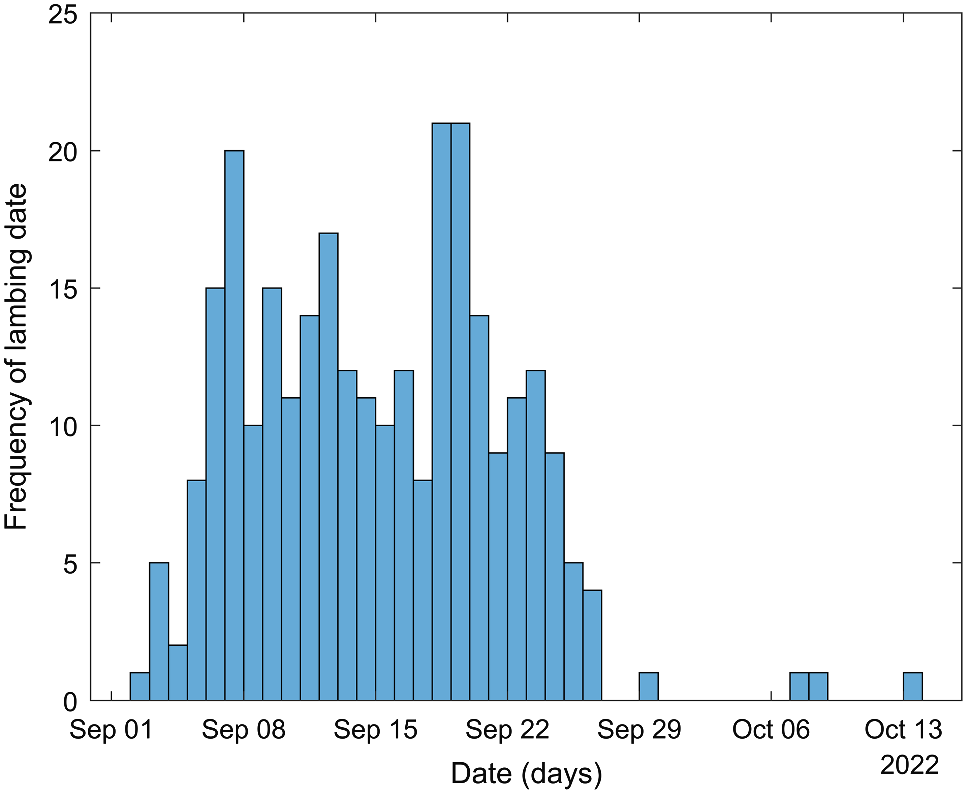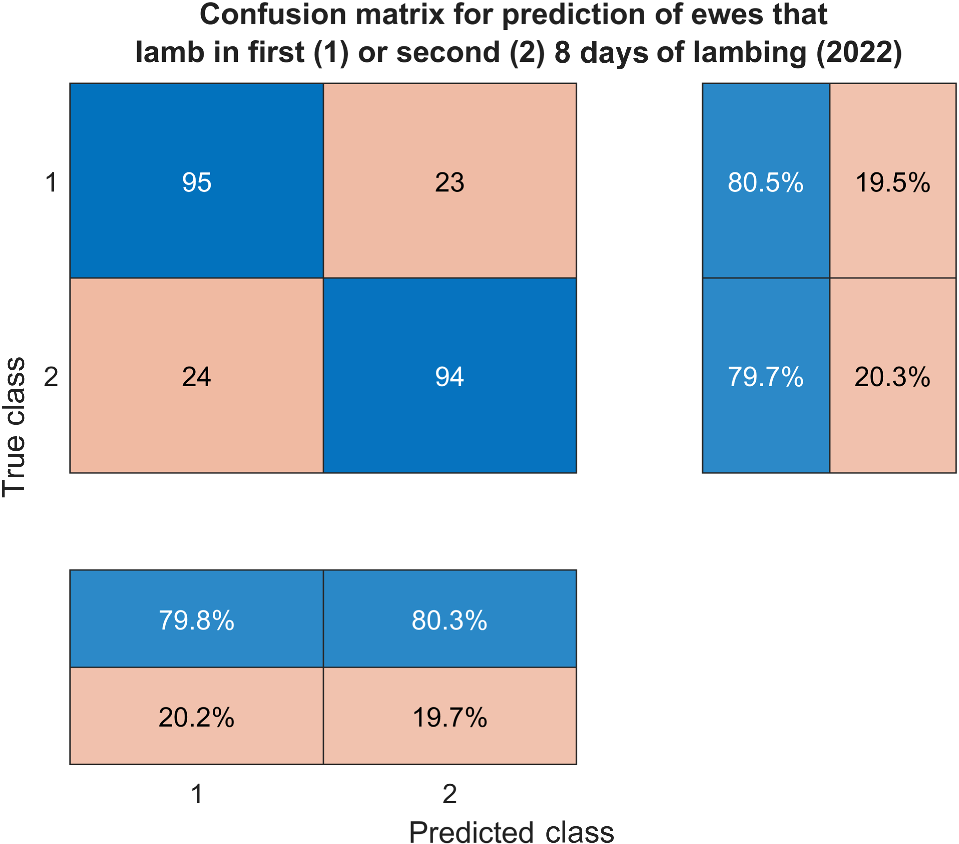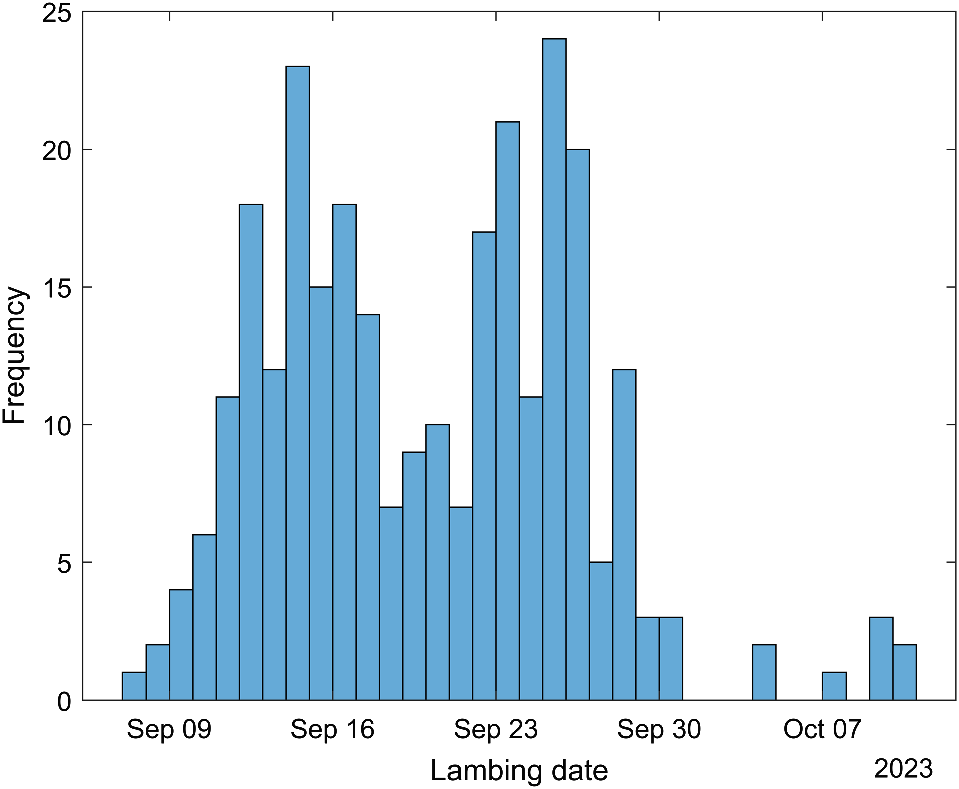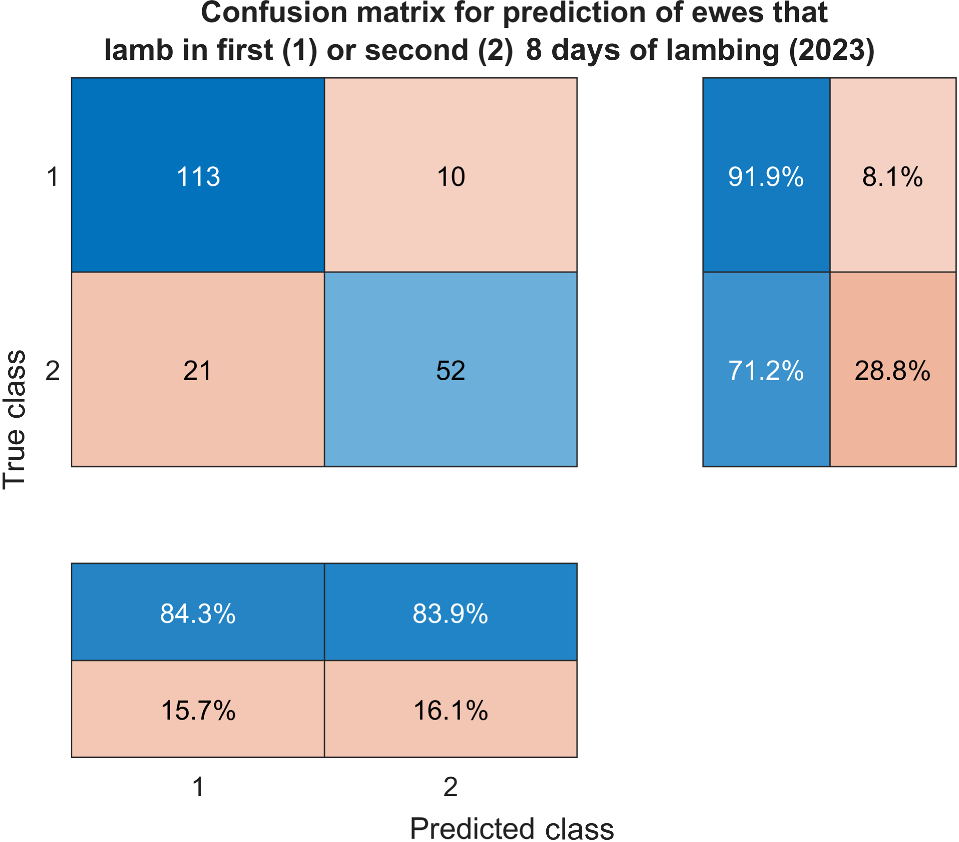Proximity sensors attached to ewes and rams at mating can predict date of lambing
P. R. Shorten A * , J. Peers-Adams B , P. L. Johnson B , C. E. O’Connor A and J. L. Juengel
A * , J. Peers-Adams B , P. L. Johnson B , C. E. O’Connor A and J. L. Juengel  B
B
A
B
Abstract
Determining the birth date of lambs is important, as it is used in analysis for the generation of breeding values for lamb liveweight and lamb growth traits.
We used proximity sensors to measure the daily interactions between 300 ewes and three rams over the mating period for two successive trial years to test the hypothesis that lambing date can be predicted for a typical New Zealand commercial mating system.
The day that the ewe had the highest number interactions with the three rams was used to estimate the day of conception.
In both trial years, 89% of ewes had a proximity sensor-based predicted lambing date ±6 days of the measured lambing date. In the two trial years, 81% and 78% of ewes had a predicted lambing date ±3 days of the measured lambing date. This demonstrates that the performance of the proximity sensor-based method to predict the lambing date was consistent between years.
Proximity sensors, therefore, provide an indirect method to study mating behaviour that can be used to predict the birth date of lambs.
This tool can be used by breeders to improve the breeding values of sires for lamb growth and liveweight when lambs are not tagged at birth, and the management of ewes by grouping them together by gestational age.
Keywords: birth date, conception, estrus, ewe, gestation length, mating, ram, sensor.
Introduction
Commercial farms in New Zealand typically conduct a 5–8-week mating period to ensure that enough ewes are pregnant over two to three 17-day reproductive cycles (Shorten et al. 2021). Gestation length varies from 142 to 152 days in sheep (Forbes 1967; Cunningham et al. 2022), which produces a 6–9-week lambing period. In breeding programs, determining the birth date of lambs is important, as it is used in analysis for the generation of breeding values for lamb liveweight and lamb growth traits (McIntyre and Newman 2016). The growth rates of lambs born earlier are overestimated if the birth date is unknown, which can bias the sire breeding value. The birth date of lambs explains 10% of the variance in weaning weight, although this is dependent on the weaning date and the distribution in lambing period (Johnson and Blair 2005). Failure to include birth date results in a 29% reduction in selection accuracy for weaning weight (the correlation between true genetic merit and predicted genetic merit), with selection based on records of the individual (Amer et al. 1999). The prediction of lambing date also allows ewes to be grouped by gestational age, and this is valuable information that commercial farmers can use to improve the management of the flock around lambing time. This information allows farmers to optimise ewe nutrition over gestation, and better time the allocation of ewes to suitable lambing paddocks to increase lamb survival (Johns et al. 2016). More accurate time of birth information also provides for improved estimation of lamb liveweight and the better management of cohorts of lambs with different liveweights (Johns et al. 2016).
Conception date can be estimated using a ram crayon harness that marks ewes during ram mounting behaviour (Juengel et al. 2020). However, this procedure is labour intensive, and ewes must be monitored periodically to ascertain the presence of crayon marks on the ewes. Crayon colours on the ram harness can be changed weekly to determine week of conception. Ultrasound scanning at approximately day 90 of gestation can also be used to determine fetal age to predict a likely birth date, although accuracy is dependent on the operator. Ewes that have not lambed can also be removed from the flock weekly to provide weekly lambing groups, although this is labour intensive, and may compromise lamb and ewe welfare. Birth date can also be obtained for breeder flocks that are monitored closely at lambing and tagged at birth, although a significant number of breeders now use DNA to assign parentage, and have reduced interaction with ewes at lambing, especially in extensive environments where birth date is unknown. There is, therefore, a need to develop technologies to provide information about the date of conception and the date of lambing.
There is a relationship between ewe mating behaviour and fertility, with greater concentrations of estradiol at estrus and an increase in the number of lambs born for ewes that mate with more rams over the mating period (Juengel et al. 2020). Proximity sensors have been used to identify that the number and duration of cow–bull interactions were both greater for oestrus cows compared with anoestrus cows (O’Neill et al. 2014). Monitoring the behaviour of ewes and rams at the time of mating thereby provides an opportunity to identify ewe oestrus and time of conception, which can then be used to predict the timing of lambing. The potential to use proximity sensors to predict lambing date has been demonstrated for Merino ewes with a ram:ewe ratio of 1:29 and 1:42 in 1-ha plots (Paganoni et al. 2020). Cunningham et al. (2022) also used proximity sensors to measure the interactions between 317 inexperienced Merino ewes and nine experienced rams during a 27-day mating period in a 50-ha paddock under commercial production conditions. Cunningham et al. (2022) found that 91% of lambing dates were predicted within ±6 days and 84% within ±3 days. Our hypothesis is that similar performance in predicted lambing date can be achieved with a ram:ewe ratio of 1:100, and smaller 1.5-ha paddocks.
Materials and methods
Animals
A single flock of 300 ewes was used for trials conducted in 2022 and 2023. The flock was managed at the AgResearch Invermay Research Farm (45.8587°S, 170.3874°E). Ewes were of mixed age, with 107 ewes born in 2018, 84 ewes born in 2019 and 109 born in 2020 for the 2022 trial. For the 2023 trial, there were 107 ewes born in 2018, 61 ewes born in 2019 and 132 ewes born in 2020. A total of 237 of the ewes in the 2023 trial were used in the 2022 trial.
Three rams were used in each trial and the flock was managed in a single paddock (approximate area of 1.5 ha (range 1.1–2.4 ha)). The three rams were replaced with three new rams midway through each trial. A crayon harness with a unique colour (orange, green, red) was attached to each ram. Ewes were exposed to rams of three breeds (red (Suffolk), green (Southdown), orange (Coopworth)). Rams were exposed to the ewes on Day −1 of the trial in 2022 and Day −2 of the trial in 2023. In the 2023 trial, the rams were initially wearing a no-mate harness, in which the no-mate part of the harness was removed on Day 1 of the trial. This was done to try to reduce noise in the dataset caused by the increased frequency of ewe ram interactions noted on the first day of introduction of the rams to the ewes in 2022. Tup checks were conducted in the yards from approximately 7:30–9:00 am on Monday, Wednesday and Friday of the trial to ascertain the presence of crayon marks on the ewes. The first tup check (Day 1) was conducted on 13 April 2022 and 17 April 2023. Tup marks were shaved off on 24 April 2022 and 28 April 2023. The final tup check was on 2 May 2022 and 8 May 2023. The pattern of tup marks was used to determine ewes that received crayon marks in their second estrus cycle (retup ewes). The date of lambing was recorded in September and October in both 2022 and 2023. The animal trial was approved by the AgResearch Animal Ethics Committee, as required by the New Zealand Animal Welfare Act 1999 (Application Number 15572 and 1912).
Proximity sensors
Proximity sensors (Smart Shepherd NZ) based on a Bluetooth technology were attached with a collar to all ewes and rams. For both years, ram collars were changed on Monday, Wednesday and Friday, whereas ewe collars were changed weekly. Interactions between individual ewes and individual rams of near proximity (approximately <2 m) were recorded on the ewe sensor. Sensor data were downloaded in the yards from approximately 7:00 to 9:00 am on Monday, Wednesday and Friday of the trial (2022) or weekly following collar change (2023). Sensor batteries were checked periodically to ensure that sensors were operational.
Data analysis
Gestation length was assumed to be 148 days with a standard deviation of 3 days (Shorten et al. 2021). Date of conception was calculated as 148 days prior to the lambing date. The total number of ewe–ram interactions were calculated over 24-h intervals. A model was developed to predict day of conception based on the day of maximum ewe interaction with the rams. The analysis in 2022 was restricted to 236 ewes that lambed on or earlier than 21 September 2022 to ensure that 97.5% of these ewes lambed from a ram interaction over the interval with proximity sensor data (the final tup check date was 2 May 2022 + 148 days – 2 × 3 days (two standard deviations in gestation length)). The analysis in 2023 was restricted to ewes that lambed on or earlier than 27 September 2023 to ensure that 97.5% of these ewes lambed from a ram interaction over the interval with proximity sensor data (the final tup check date was 8 May 2023 + 148 days – 2 × 3 days (two standard deviations in gestation length)). Ewes with a predicted date of conception on Day 1 and Day 2 were removed, as their oestrus would have overlapped the times that rams were wearing the no-mate harness in 2023, which were removed on Day 1.
The relationship between lambing date in 2022 and lambing date in 2023 was analysed with a linear regression. The relationship between the predicted conception date in 2022 and the predicted conception date in 2023 based on the day of maximum interaction with the ram was analysed with a linear regression. The relationship between the deviation between observed and predicted lambing date in 2022 and the deviation between observed and predicted lambing date in 2023 was also analysed with a linear regression.
The relationship between tup mark date, retup mark date (later of two dates) and the date of conception (calculated as lambing date – 148 days) was analysed with a linear regression. The regression bias was calculated and used to estimate the average gestation length for this flock. The regression root mean square error (RMSE) was used to estimate the standard deviation in gestation length (the 12 ewes that were not within three times the standard deviation in gestation length of 3 days (99% confidence interval) were considered outliers and were excluded for the calculation of the RMSE).
The confusion matrix for classifying ewes that lambed in the first 8 days (positive) or the second 8 days (negative) of lambing in 2022 and 2023 (based on the day of maximum interaction with the ram) was calculated. The number of true positives (TP), false positives (FP), true negatives (TN) and false negatives (FN) were calculated for each classifier. The model precision (TP / (TP + FP)), sensitivity (TP / (TP + FN)) and F1 statistic (harmonic mean of precision and sensitivity) were calculated.
Results
2022 trial
The distribution of lambing date in 2022 is shown in Fig. 1. Ewes predominantly lambed over a 4-week period from 1 September. The average date of lambing in 2022 was 14, 14 and 15 of September for 2018, 2019 and 2020 born ewes, respectively.
The relationship between predicted day of conception based on the day of maximum ewe interaction with the rams and measured day of conception in 2022 is shown in Fig. 2 (R2 = 0.45; RMSE = 3.82 days; n = 236). The measured date of conception has a standard deviation of 5.15 days and the measurement error of predicted day of conception has a standard error of approximately 3 days, so that the maximum possible model R2 is 0.66 (1–32 / 5.52). Based on the pattern of residuals, the expected gestation length is 146 days. A total of 89% of ewes had a predicted date of conception ±6 days of the measured date of conception. A total of 81% of ewes had a predicted date of conception ±3 days of the measured date of conception. Outliers were evenly distributed above and below the regression line based on a 146-day gestation.
The relationship between predicted day of conception (relative to 11 April 2022) using proximity data and the day of maximum ewe interaction with the ram and measured day of conception (lambing date – 148 days; R2 = 0.45; RMSE = 3.82 days; n = 236). Random noise with a standard deviation of 0.2 days was added to the measured day of conception in 2022 to better reveal the distribution of the data (so that ewes with the same combination of predicted and measured day are slightly offset). Circle symbols denote a predicted date of conception within 3 days of the measured date of conception, plus symbols denote a predicted date of conception within 6 days of the measured date of conception and cross symbols denote a predicted date of conception not within 6 days of the measured date of conception. The solid line denotes the 1:1 line assuming a 148-day gestation and the dotted line denotes the relationship with a 146-day gestation.
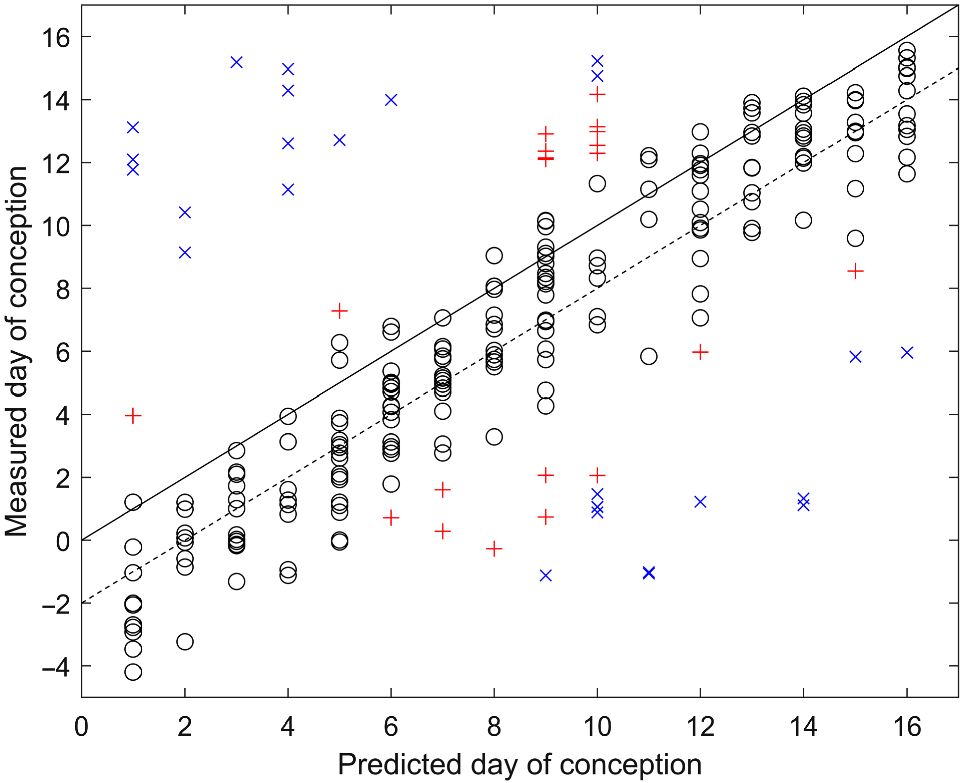
The relationship between measured tup date and measured lambing date for ewes that lambed on or before 21 September 2022 is shown in Fig. 3 (R2 = 0.8; RMSE = 2.3 days; n = 227). Based on the pattern of residuals, the expected gestation length is 146 days with a standard deviation of 2.30 days.
The relationship between measured tup date and measured lambing date for ewes that lambed on or before 21 September 2022 (R2 = 0.8; RMSE = 2.3 days; n = 227). Random noise with a standard deviation of 0.2 days was added to the lambing date to better reveal the distribution of the data (so that ewes with the same combination of predicted and measured date are slightly offset).
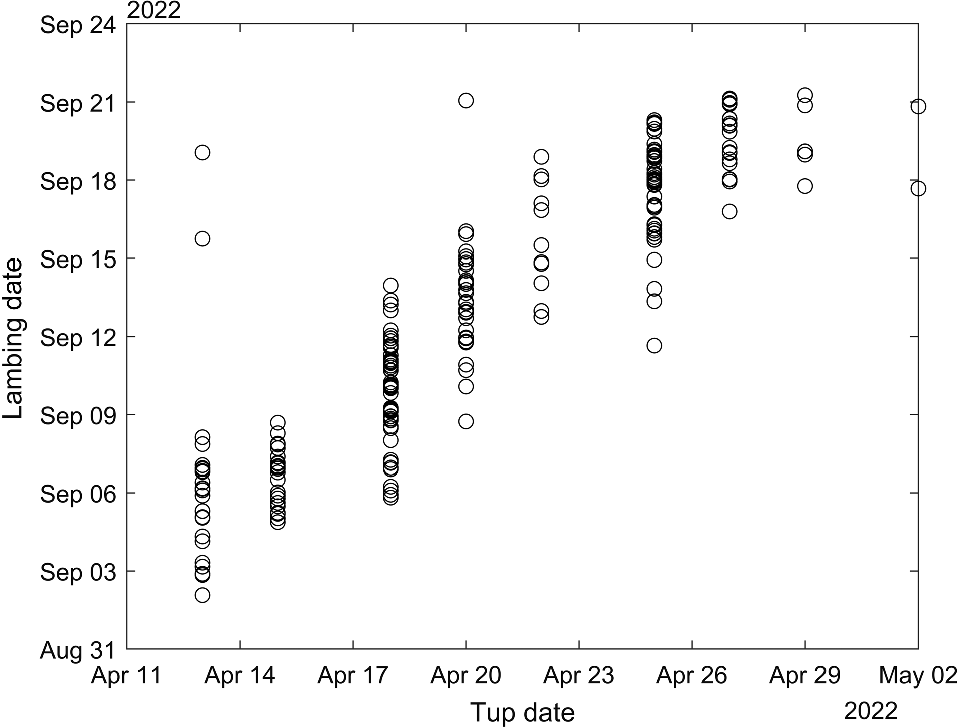
The confusion matrix for the classification of ewes that lamb in the first 8 days or the second 8 days of lambing in 2022 (based on the day of maximum interaction with the ram) is shown in Fig. 4. The model for classification of ewes that lamb in the first 8 days of lambing has a precision of 79.8%, sensitivity of 80.5% and an F1 statistic of 80.2%.
2023 trial
The distribution of lambing date in 2023 is shown in Fig. 5. Ewes predominantly lambed over a 3-week period from 7 September. The average date of lambing in 2023 was 19, 20 and 19 September for 2018, 2019 and 2020 born ewes, respectively.
The relationship between predicted day of conception based on the day of maximum ewe interaction with the rams and measured day of conception in 2023 is shown in Fig. 6 (R2 = 0.41; RMSE = 3.84 days; n = 196). The data are consistent with a gestation length of 146 days. The measured date of conception has a standard deviation of 5.45 days and the measurement error of day of conception has a standard deviation of approximately 3 days, so that the maximum possible model R2 is 0.70 (1–32 / 5.452). A total of 89% of ewes had a predicted date of conception ±6 days from the measured date of conception. A total of 78% of ewes had a predicted date of conception ±3 days from the measured date of conception.
The relationship between predicted day of conception (relative to 17 April 2023, Day 1) based on the day of maximum ewe interaction with the ram and measured day of conception based on lambing date minus 148 days (R2 = 0.41; RMSE = 3.84 days; n = 196). Random noise with a standard deviation of 0.2 days was added to the measured day of conception in 2023 to better reveal the distribution of the data (so that ewes with the same combination of predicted and measured day are slightly offset). Circle symbols denote a predicted date of conception within 3 days of the measured date of conception, plus symbols denote a predicted date of conception within 6 days of the measured date of conception and cross symbols denote a predicted date of conception not within 6 days of the measured date of conception. The solid line denotes the 1:1 line assuming a 148-day gestation and the dotted line denotes the relationship with a 146-day gestation.
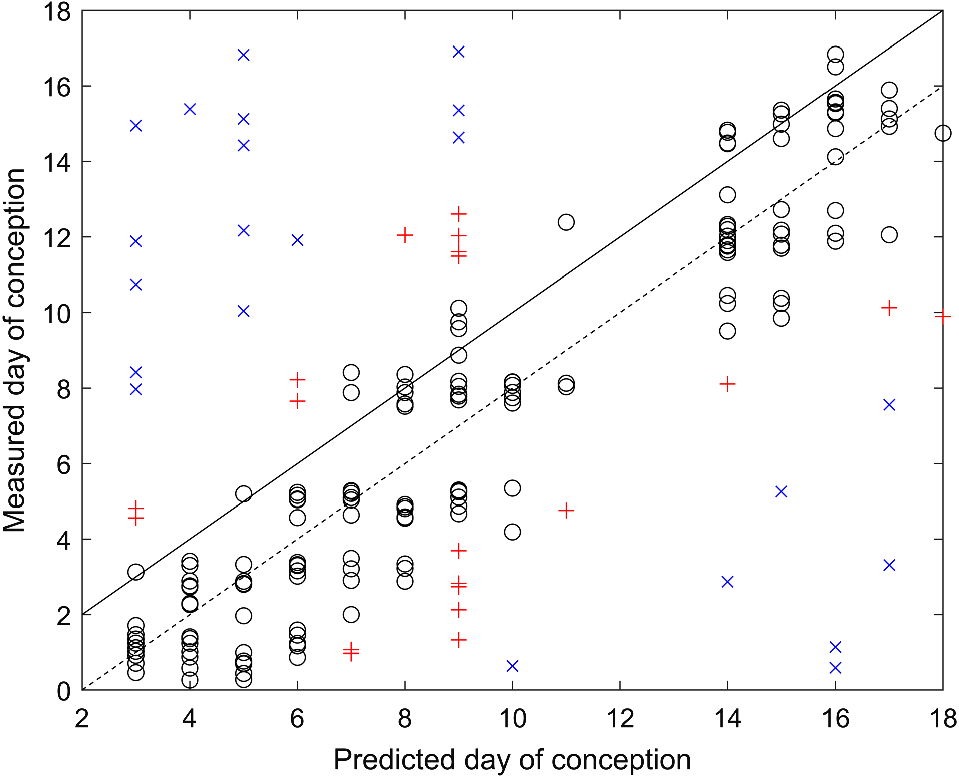
The relationship between tup mark date, retup mark date (later of two dates) and the date of conception (calculated as lambing date – 148 days) is shown in Fig. 7 (n = 242). The data are consistent with a gestation length of 146 days with a standard deviation of 2.31 days (based on the 230 ewes (red points in Fig. 7) within three times the standard deviation in gestation length of 3 days (99% confidence interval)).
The relationship between tup mark date, retup mark date (later of two dates) and the date of conception (calculated as lambing date – 148 days; n = 242). The solid line denotes the 1:1 line assuming a 148-day gestation and the dotted line denotes the relationship with a 146-day gestation. Red points denote a date of conception within 9 days of the dotted line. Random noise with a standard deviation of 0.2 days was added to the date of conception to better reveal the distribution of the data (so that ewes with the same combination of predicted and measured date are slightly offset).
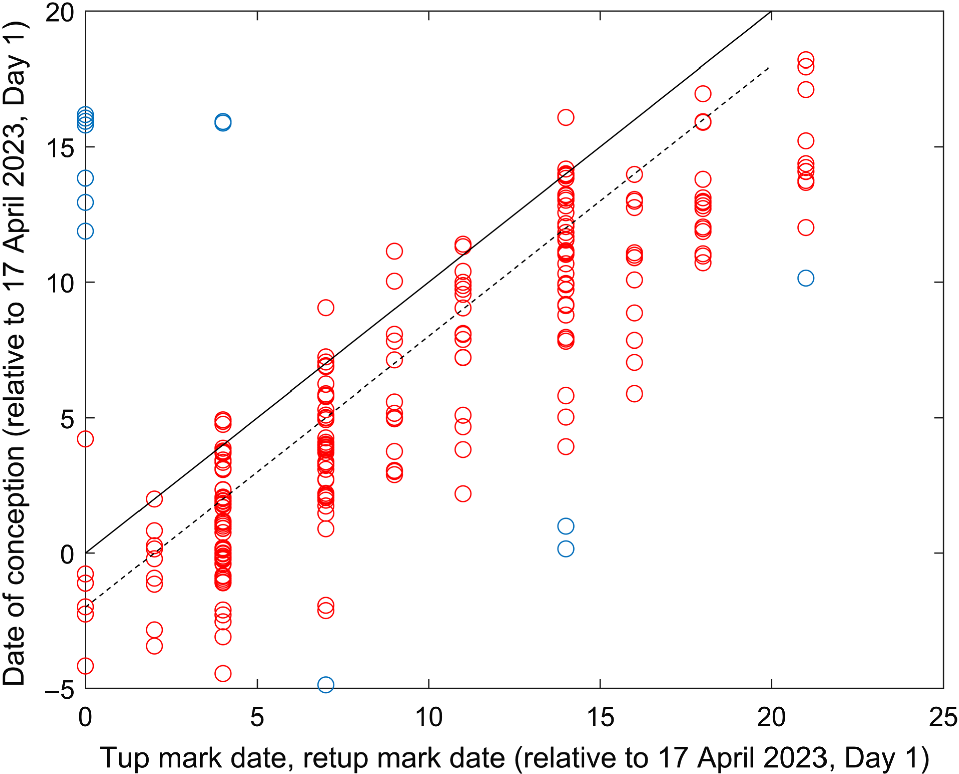
The confusion matrix for the classification of ewes that lamb in the first 8 days or the second 8 days of lambing in 2023 (based on the day of maximum interaction with the ram) is shown in Fig. 8. The model for classification of ewes that lamb in the first 8 days of lambing has a precision of 84.3%, sensitivity of 91.9%, and an F1 statistic of 87.9%.
Repeatability of lambing date
There was no relationship between lambing date in 2022 and lambing date in 2023 (R2 = 0.00; n = 183). The lack of a relationship highlights that the repeatability of lambing date was very low. There was no relationship between the predicted conception date in 2022 and the predicted conception date in 2023 based on the day of maximum interaction with the ram (R2 = 0.01; n = 163). There was no relationship between the deviation between observed and predicted lambing date in 2022 and the deviation between observed and predicted lambing date in 2023 (R2 = 0.00; n = 131). The strength of the correlation was very low, and there were only two ewes with a predicted date of conception >4 days from the measured date of conception in both the 2022 and 2023 trials, which is consistent with random chance.
Discussion
In both trial years, 89% of ewes had a proximity sensor-based predicted lambing date ±6 days of the measured lambing date. In the two trial years, 81% and 78% of ewes had a predicted lambing date ±3 days of the measured lambing date. This demonstrates that the performance of the proximity sensor-based method to predict lambing date was consistent between years. These results are also consistent with Cunningham et al. (2022), who found that 91% of lambing dates were predicted within ±6 days and 84% within ±3 days. Our results are also consistent with a smaller study by Paganoni et al. (2020), who found that 100% of lambing dates were predicted within ±6 days and 93% within ±3 days, although 10% of ewes that did not display a clear peak in the number of interactions with the ram were excluded from analysis. Our study had 300 ewes and three rams, and demonstrated that similar performance in predicted lambing date can be achieved with a ram:ewe ratio of 1:100, and a higher stocking density in 1.5-ha paddocks. Our trial deployed proximity sensors over a 21-day period at the start of mating, and future trials with proximity sensors over a 5–8-week mating period that are typical for commercial farms in New Zealand are required to assess the accuracy of the predicted date of birth for late lambing ewes. We also found that the group of ewes with low performance of the proximity sensor-based prediction of lambing date in 2022 was not related to the group of ewes with low performance of the proximity sensor-based prediction of lambing date in 2023. This suggests that failure of the proximity sensors to accurately predict lambing date in some ewes is not related to a repeatable ewe behavioural trait over the mating period, although further study of ewe and ram behaviour over the mating period for ewes with low performance of the proximity sensor-based prediction of lambing date is required.
Based on the pattern of residuals between measured tup date and measured lambing date, the expected gestation length in this flock is 146 days with a standard deviation of 2.3 days. The variability in gestation length is breed and flock dependent, and is an important factor for prediction of lambing date based on time of conception. A predicted lambing date ±3 days of the measured lambing date of 81% is also consistent with a standard deviation in gestation length of 2.3 days. Cunningham et al. (2022) found that 84% of lambing dates were predicted within ±3 days (317 ewes), which is consistent with a standard deviation in gestation length of <2.13 days. Paganoni et al. (2020) found that the standard deviation in the difference between predicted and measured birth date was 1.88 days (55 ewes), which provides an upper bound for the standard deviation in gestation length. Cunningham et al. (2022) and Paganoni et al. (2020) also estimated a gestation length of 150 days for Merino ewes based on proximity sensor-based prediction of lambing date.
The classification of ewes that lamb in the start or end of lambing is valuable information that commercial farmers can use to improve management of the flock around lambing time. Based on the day of maximum interaction with the ram, the model for classification of ewes that lamb in the first 8 days of lambing has a precision of 80–84%, sensitivity of 81–92% and an F1 statistic of 80–88% based on the two trials. This information would allow farmers to optimise ewe nutrition over gestation and better timing of the allocation of ewes to lambing paddocks. More accurate time of birth information also provides for improved estimation of lamb liveweight and the better management of cohorts of lambs with different liveweight.
There is potential to improve the proximity sensor-based prediction of lambing date by utilising a combination of sensors. Animal-attached accelerometers, video, GPS and acoustic sensors could be used to provide extra information about mating behaviour and lambing date. Harness-mounted accelerometers have been used for the remote detection of mounting behaviour in rams (Mozo et al. 2019; Goldsmith et al. 2022). Video-based deep learning algorithms have also been used to predict ram mounting behaviour in indoor environments (Yu et al. 2023). Halter-attached accelerometers attached to ewes at the time of lambing have also been used to predict the date of lambing based on a decrease in the time ewes spend grazing and ruminating, but an increase in the time ewes spent licking (Sohi et al. 2022). There is also potential to predict date of lambing based on the acoustic sensor detection of the vocalisation patterns (Shorten and Hunter 2023) of ewes and lambs. GPS sensors also have the potential to be used to detect the pattern of mating behaviour and the date of lambing (Brushett et al. 2023).
Conclusion
In this study, we used proximity sensors to measure the daily interactions between 300 ewes and three rams over a 21-day mating period for two successive trial years to determine that lambing date can be accurately predicted for a typical New Zealand commercial mating system. The performance of the proximity sensor-based method to predict lambing date was consistent between years. This tool can be used by breeders to improve the breeding values of sires for lamb growth and liveweight traits, and by commercial farmers for improved management of ewes by grouping them together by the gestational age of the foetus(es) they are carrying.
Data availability
Data used in the manuscript are available from the corresponding author upon reasonable request.
Declaration of funding
This work was funded by the Strategic Science Investment Fund from New Zealand Ministry of Business, Innovation and Employment, and the Sustainable Food and Fibre Futures fund from New Zealand Ministry for Primary Industries.
Acknowledgements
The authors thank Smart Shepherd NZ for providing the proximity sensors and technical assistance with hardware for this trial. The authors also thank the Invermay Farm team for their support with the trial.
References
Amer PR, Garrick DJ, Nicoll GB (1999) The importance of date of birth records in genetic evaluation of deer. Proceedings of the New Zealand Society of Animal Production 59, 129-130.
| Google Scholar |
Brushett A, Whittington J, Macbeth B, Fryxell JM (2023) Changes in movement, habitat use, and response to human disturbance accompany parturition events in bighorn sheep (Ovis canadensis). Movement Ecology 11, 36.
| Crossref | Google Scholar | PubMed |
Cunningham K, Van Burgel A, Kelman KR, Macleay CM, Paganoni BL, Thompson AN (2022) Interactions between ewes and rams during mating can be used to predict lambing dates accurately, but not sire. Animals 12, 1707.
| Crossref | Google Scholar | PubMed |
Forbes JM (1967) Factors affecting the gestation length in sheep. Journal of Agricultural Research 68, 191-194.
| Crossref | Google Scholar |
Goldsmith EL, Rickard JP, Mercorelli LR, Gonzàlez LA, de Graaf SP (2022) The use of accelerometers for the remote detection of mounting in rams and testosterone-treated wethers. Computers and Electronics in Agriculture 199, 107129.
| Crossref | Google Scholar |
Johns C, Johns J, Stevens DR (2016) Increasing lamb survival and lamb weaning weight through feeding high fecundity crossbred sheep. Journal of New Zealand Grasslands 16, 323-328.
| Crossref | Google Scholar |
Johnson PL, Blair HT (2005) A comparison of different non-genetic models to describe lamb weights when using DNA to assign sire. Proceedings of the Association for the Advancement of Animal Breeding and Genetics 16, 215-218.
| Google Scholar |
Juengel JL, Quirke LD, Hyslop K, Meenken ED, Peers-Adams J, Smith P, Edwards SJ (2020) Association of fertility with group mating behavior in ewes. Animal Reproduction Science 216, 106359.
| Crossref | Google Scholar | PubMed |
McIntyre S, Newman SN (2016) Impact of date of birth recording practises in genetic evaluation in New Zealand sheep. Proceedings of the New Zealand Society of Animal Production 76, 59-61.
| Google Scholar |
Mozo R, Alabart JL, Rivas E, Folch J (2019) New method to automatically evaluate the sexual activity of the ram based on accelerometer records. Small Ruminant Research 172, 16-22.
| Crossref | Google Scholar |
O’Neill CJ, Bishop-Hurley GJ, Williams PJ, Reid DJ, Swain DL (2014) Using UHF proximity loggers to quantify male–female interactions: a scoping study of estrous activity in cattle. Animal Reproduction Science 151, 1-8.
| Crossref | Google Scholar | PubMed |
Paganoni B, Macleay C, van Burgel A, Thompson A (2020) Proximity sensors fitted to ewes and rams during joining can indicate the birth date of lambs. Computers and Electronics in Agriculture 170, 105249.
| Crossref | Google Scholar |
Shorten PR, Hunter LB (2023) Acoustic sensors for automated detection of cow vocalization duration and type. Computers and Electronics in Agriculture 208, 107760.
| Crossref | Google Scholar |
Shorten PR, Edwards SJ, Juengel JL (2021) The role of reproductive loss on flock performance: a comparison of nine industry flocks. Translational Animal Science 5, 1-20.
| Crossref | Google Scholar |
Sohi R, Almasi F, Nguyen H, Carroll A, Trompf J, Weerasinghe M, Bervan A, Godoy BI, Ahmed A, Stear MJ, Desai A, Jois M (2022) Determination of ewe behaviour around lambing time and prediction of parturition 7 days prior to lambing by tri-axial accelerometer sensors in an extensive farming system. Animal Production Science 62, 1729-1738.
| Crossref | Google Scholar |
Yu L, Guo J, Pu Y, Cen H, Li J, Liu S, Nie J, Ge J, Yang S, Zhao H, Xu Y, Wu J, Wang K (2023) A recognition method of ewe estrus crawling behavior based on multi-target detection layer neural network. Animals 13, 413.
| Crossref | Google Scholar | PubMed |


